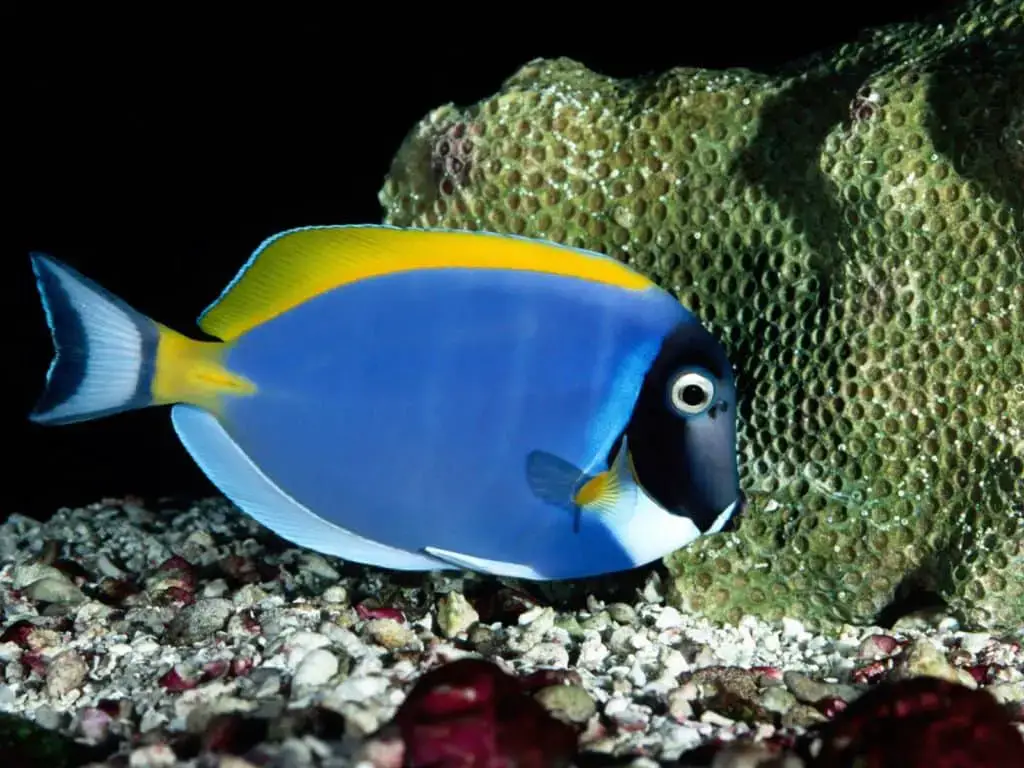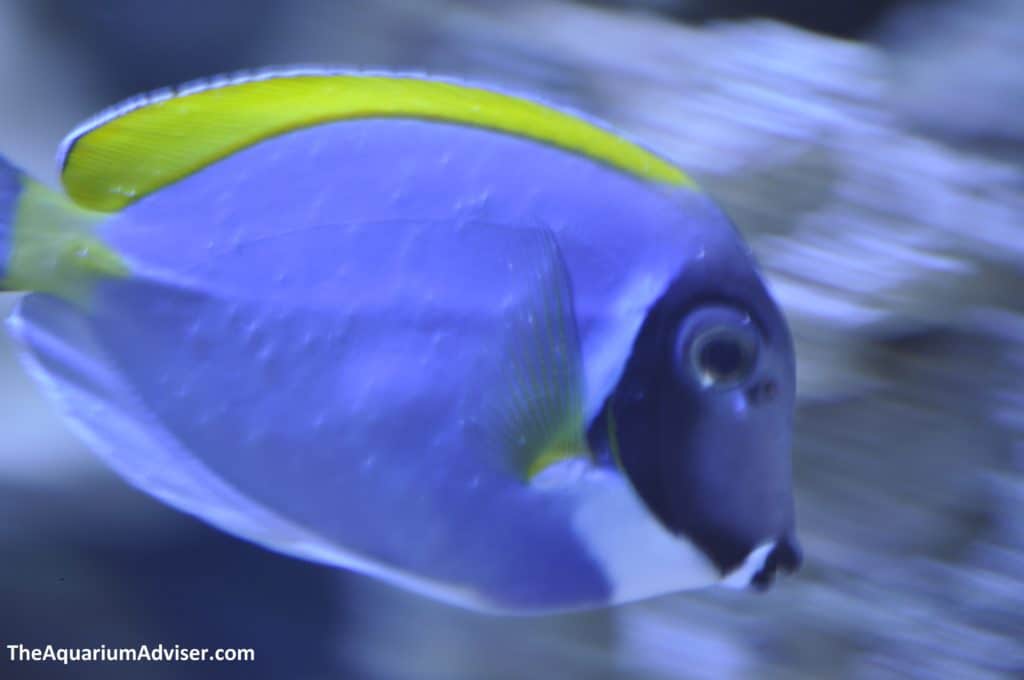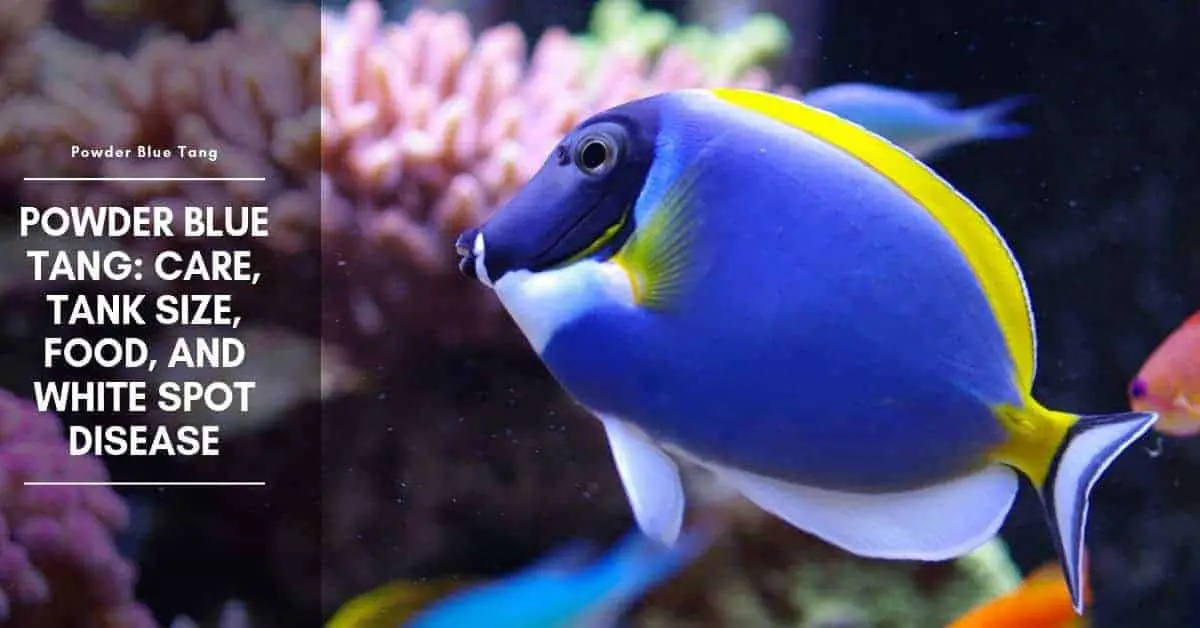If you’re looking for a fish that will try to shank any new additions, using the blade at the base of its tail, the powder blue tang might just be the fish for you.

When it comes to keeping a powder blue tang, they can be just as frustrating as many other members of the Acanthurus family, as the majority of them have a lower survival rate than average.
Coloring and markings
These fish are easy to recognize with their light blue oval bodies adorned with a yellow dorsal fin, creating a striking contrast. For years I wanted a powder blue tang in my reef tank, however, I managed to resist the temptation, because of the horror stories and emaciated specimens which I kept seeing in the shops. This is something I’ve got pretty good at over the years, whenever there’s a fish which has a terrible reputation, I’m always more than happy to wait until another reefer is shutting down their tank and is selling one.
Obviously, you might have to wait years to get the right fish, but it significantly increases your chance of success.
Powder blue tang survival rate
The poor survival rate is directly a result of two major issues:
The first being that they’re rather partial to the occasional zero-calorie diet plan where they would rather starve than eat literally anything.
Secondly, they are a magnet for various diseases, but especially ‘white spot’. This fish really should only be purchased if you’re willing to plan your tank around it.
API STRESS ZYME Freshwater and Saltwater Aquarium Cleaning Solution 16-Ounce Bottle
API ACCU-CLEAR Freshwater Aquarium Water Clarifier 4-Ounce Bottle
30% OffAPI GENERAL CURE Freshwater and Saltwater Fish Powder Medication 10-Count Box
15% OffTank size
They need a considerable size tank with selective tank mates. A rectangle tank is a better choice than a cube, as it gives them a larger swimming distance. Something which I feel is often overlooked is that they need a tank with lots of flow. In the world, they come from an oxygen-rich environment, therefore we should try to replicate this in the home aquarium with multiple powerheads.
Selecting the powder blue Tang
As I mentioned, just keeping them alive isn’t mean their problems stop. They’re notorious for being very aggressive, and once established it’s not unusual for them to try to kill any new tank mates. When selecting a fish, only select one which is actively swimming. Inspect them closely for any signs of disease and ensure that you see them feeding ferociously at the shop first. This last bit is the key to your success.
Quarantine the powder blue tang
Assuming you find a specimen, which takes all these boxes, I still strongly advise that you quarantine their species. This gives you a chance to monitor its behavior, while also allowing the fish to acclimate to life in captivity in the peace and comfort of an empty tank.
Give a variety of foods to your fish
It also gives you the chance to offer a variety of foods in which the fish can test its own pace without any competition. This is important as these fish can be extremely finicky feeders, and will go on hunger strike at the drop of a hat. A large tank engaging them to eat more than one thing is key, and if one day decides is not interested in one type of food, you have a range of other options to try.
This will also provide the fish with a more nutritious diet, which will further strengthen their immune system. Fish can and do learn to accept different types of food. Patience in some cases, tricking them is a good place to start. Over time this fish will become quite bold and even tame with some being more than happy to take food right out of your hands, and occasionally will even let you stroke her.
Plenty of live rock is a must, as this fish will cruise the rocks all day picking algae.
White spot treatment

Please be aware that when you purchase this fish a “white spot” outbreak is virtually unavoidable for the average Acanthurus. But don’t panic, once a fish is developed white spot you need to decide when the appropriate time to act is. Stress causes the mucus layer the fish produces, to become thinner, allowing the parasite to attach. Removing the fish from the display tank can be incredibly stressful, which in my opinion can cause more harm than good sometimes. for this reason, minor outbreaks on this fish aren’t too much of a worry and it isn’t uncommon for us to have a few little white spots every now and again.
I’m merely pointing out that removing a fish from the display tank is not only stressful for the sick fish, but it can also be stressful for the other tank inhabitants as well.
In conclusion
So in answer to the question, “do you really want a powder blue tang?”, this fish can be a nightmare to keep. They’re prone to disease, hunger strikes, and random bouts of thuggish aggression. However, if you’re willing to put in the time and effort to create the optimum environment, they can be a brilliant show fish that stands out above the rest.

Hi, my name is Sean, and I’m the primary writer on the site. I’m blogging mostly about freshwater and saltwater aquariums, fish, invertebrates, and plants. I’m experienced in the fishkeeping hobby for many years. Over the years I have kept many tanks, and have recently begun getting more serious in wanting to become a professional aquarist. All my knowledge comes from experience and reading forums and a lot of informative sites. In pursuit of becoming a professional, I also want to inspire as many people as I can to pick up this hobby and keep the public interest growing.
Read more about Sean.
Please join also my Facebook group.















